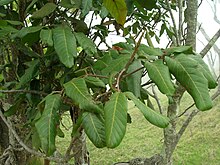| Alectryon macrococcus | |
|---|---|

| |
| A. m. var. auwahiensis | |
| Scientific classification | |
| Kingdom: | Plantae |
| Clade: | Tracheophytes |
| Clade: | Angiosperms |
| Clade: | Eudicots |
| Clade: | Rosids |
| Order: | Sapindales |
| Family: | Sapindaceae |
| Genus: | Alectryon |
| Species: | A. macrococcus
|
| Binomial name | |
| Alectryon macrococcus | |
Alectryon macrococcus, known as ʻAlaʻalahua or Māhoe in Hawaiian, is a slow-growing flowering tree in the soapberry family, Sapindaceae, that is endemic but manifests rarely in mesic forests of Kauai, Oahu, Molokai, and Maui Hawaii.[2] The tree grows to a maximal height of about 10 meters with leaves 3 to 30 cm long with two to five pairs of elliptic pinnae. The pinnae are smooth, glossy and net-veined, 4 to 10 inches long and 2 to 5 inches. Fruits are from 1 to 3 inches in diameter with a single black seed embedded in a red, fleshy aril[3] More than a century ago, it was noted that Hawaiians ate the fleshy, insipid and slightly sweet arils and mildly flavored seeds.[4]
Alectryon macrococcus var. auwahiensis has been found growing naturally only (endemic) in Maui, where it grows in Hawaiian tropical dry forests on the south slope of Haleakalā at elevations of 360–1,070 m (1,180–3,510 ft).[5][6][7][8] It is threatened by habitat loss.
Alectryon macrococcus var. macrococcus inhabits mesic forests at elevations of 365–1,035 m (1,200–3,400 ft) on Kauaʻi, Oʻahu, Molokaʻi and western Maui.[7][8][9][10]
These trees can reach 11 m (36 ft) tall. Their leaves are each made up of oval-shaped, asymmetrical, net-veined leaflets. Variety auwahiensis has leaflets with rusty-red undersides.[11] The fruits contain a seed with a bright red aril. The arils are sweet-tasting and were food for native Hawaiians.[11] The seeds also attract rats, whose consumption of them prevents the plants of this endangered species from reproducing.[11] The black twig borer (Xylosandrus compactus) destroys the twigs.[12]
